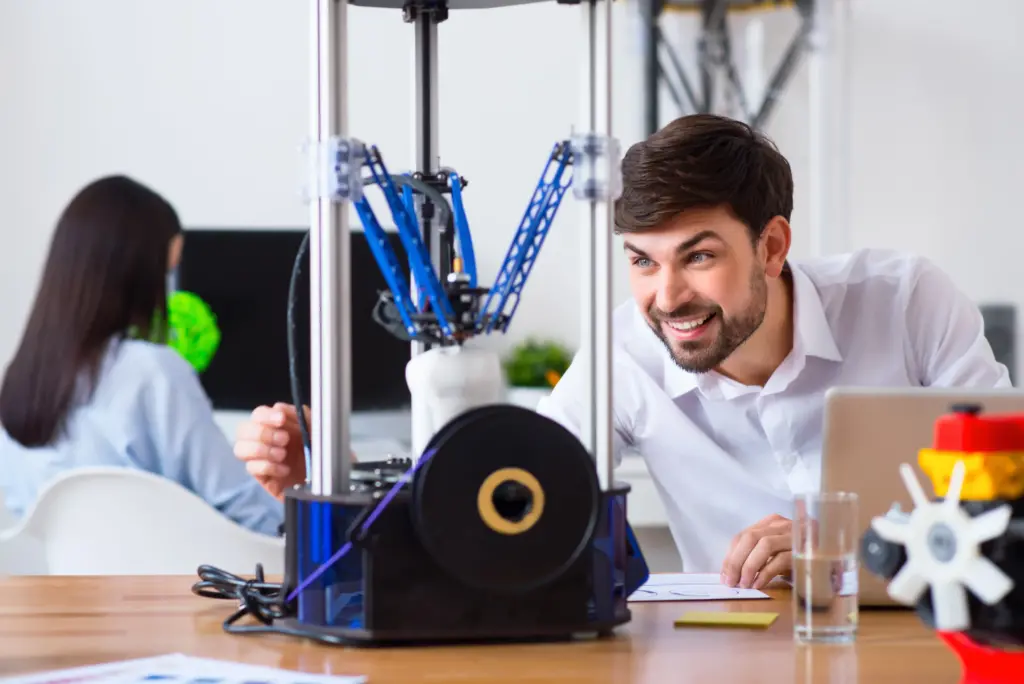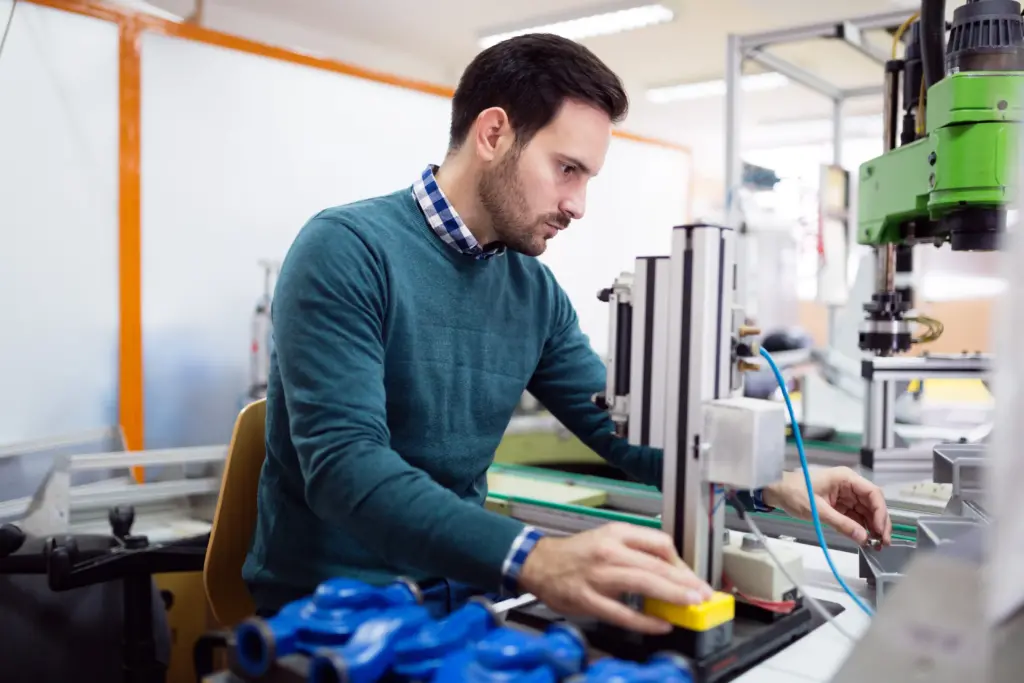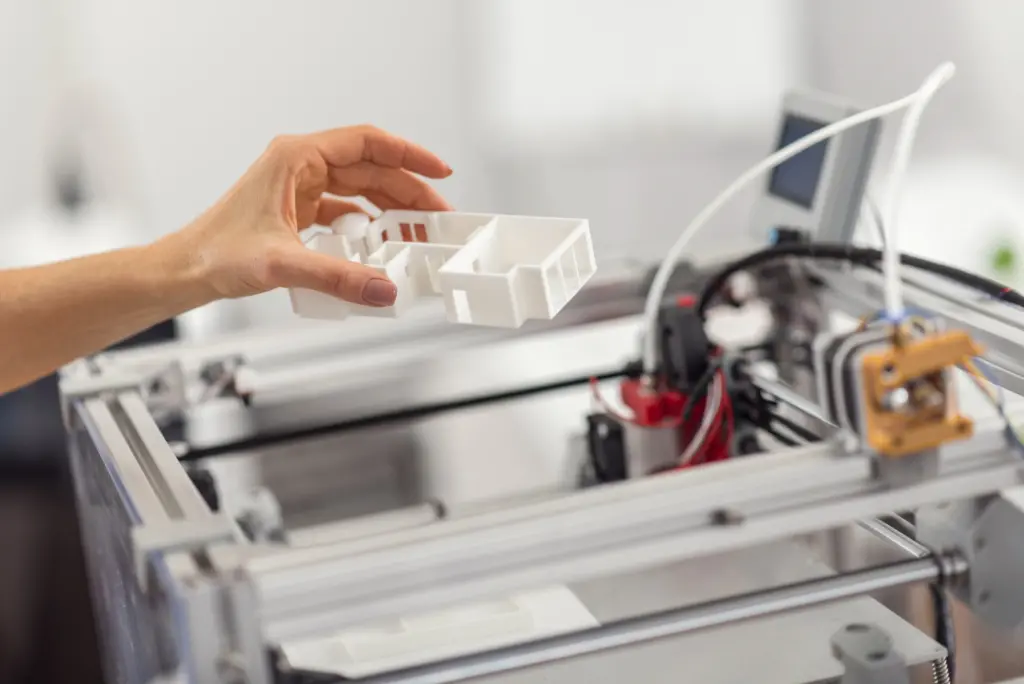3D Printing Business: A Comprehensive Guide to Starting and Thriving in the Industry
Hey fellow 3D printing enthusiasts! Ever thought of turning your passion into profit? Dive in as we explore the exhilarating world of the 3D printing business.
1. The Rise of 3D Printing in Business
From hobbyists’ garages to the global market, 3D printing has exploded in popularity. With rapid technological advancements and the potential to transform industries, it’s no wonder entrepreneurs are keen to jump aboard.
2. Why Start a 3D Printing Business?
3D printing, also known as additive manufacturing, is revolutionizing the way we create and produce objects. This innovative technology offers a plethora of advantages, making a 3D printing business an attractive venture in today’s market. Here’s a deeper look into why embarking on a 3D printing business could be a smart move:
Unmatched Flexibility in Design and Production
- Rapid Prototyping: 3D printing allows for quick and cost-effective production of prototypes. Businesses can iterate designs faster, test more thoroughly, and bring products to market quicker than ever before.
- Complex Geometries Made Simple: Traditional manufacturing methods often struggle with complex designs. 3D printing excels in creating intricate and detailed objects that would otherwise be impossible or too expensive to produce.
Personalization at Its Peak
- Customization: One of the most significant advantages of 3D printing is the ability to customize products. Whether it’s tailor-made medical implants or personalized consumer products, 3D printing can cater to specific needs and preferences of individual customers.
- Niche Markets: This technology opens up opportunities in niche markets. From bespoke jewelry to custom automotive parts, businesses can target specific segments with unique offerings.
Speed: From Concept to Reality
- Reduced Time-to-Market: The speed at which 3D printing can turn a concept into a physical object is unparalleled. This rapid production capability significantly shortens the time-to-market for new products.
- On-Demand Manufacturing: With 3D printing, businesses can produce on demand, reducing the need for large inventories and storage space. This not only saves costs but also allows for quicker response to market trends and customer demands.
Cost-Effective and Environmentally Friendly
- Reduced Waste: Traditional manufacturing often involves cutting away material, leading to significant waste. 3D printing adds material layer by layer, minimizing waste and promoting sustainable practices.
- Lower Overhead Costs: Setting up a 3D printing operation generally requires less space and fewer employees compared to traditional manufacturing setups. This leads to lower overhead costs, making it an accessible option for startups and small businesses.
Accessibility and Technological Advancement
- Growing Accessibility: As 3D printing technology advances, the cost of printers and materials is decreasing, making it more accessible than ever. This democratization of technology paves the way for innovation and creativity.
- Continuous Innovation: The field of 3D printing is constantly evolving, with new materials and techniques being developed regularly. This ensures that businesses in this sector stay at the forefront of technological advancement.
3. Niche Opportunities in 3D Printing

There’s a plethora of opportunities waiting for you. Let’s dive deeper.
Prototyping Services
In the dynamic world of startups and innovation, prototyping services play a pivotal role. As an essential element in the development and pitching of new product ideas, these services offer startups and inventors the opportunity to bring their visions to life. Here’s an in-depth look at how a 3D printing business can maximize its impact in prototyping services:
Understanding the Essence of Prototyping
- Beyond Object Creation: Prototyping in the 3D printing realm transcends mere object creation. It’s about materializing an idea into a tangible form, allowing for a comprehensive evaluation of design, functionality, and viability.
- Rapid Development and Iteration: Speed is a game-changer in prototyping. The ability to quickly produce, assess, and refine a prototype can significantly accelerate the development process, making it a valuable tool for startups eager to present their products to investors or enter the market.
Proficiency in Advanced Software and Design
- Software Mastery: Familiarity with top-tier design software such as AutoCAD, Tinkercad, and Blender is paramount. Choosing the right software depends on the complexity of the designs and the specific needs of the targeted industry.
- Continuous Skill Enhancement: The 3D printing landscape is ever-evolving. Staying updated with the latest software developments and design techniques is essential for maintaining a competitive edge and delivering high-quality prototypes.
Building Collaborations and Networks
- Engaging with Startups and Inventors: Establishing connections with local startup incubators, participating in innovation events, and conducting workshops can open doors to new collaborations and opportunities.
- Understanding Client Needs: Active engagement with clients helps in understanding their specific needs, challenges, and goals. This client-centric approach ensures the development of prototypes that accurately reflect their vision and requirements.
Specializing in Target Industries
- Industry-Specific Prototyping: Different industries have varying prototype requirements. For instance, the automotive sector might prioritize functional prototypes for testing parts, while the consumer goods industry might focus more on the aesthetic and ergonomic aspects of a design.
- Customized Solutions: Tailoring services to meet the unique demands of each industry is crucial. This involves not only understanding the technical requirements but also the market trends and consumer expectations within those sectors.
Customized Merchandise
Customized merchandise represents a significant opportunity in the current market, where personalization and uniqueness are highly valued by consumers. From crafting personalized jewelry to creating bespoke home decor, the possibilities are endless in this niche. Here’s an in-depth exploration of how to effectively tap into the world of customized merchandise:
Embracing the Power of Personalization
- Sentimental Value: Customized items, be it jewelry, keychains, or home décor, are not just products; they are personal statements. They hold a sentimental value that mass-produced items cannot match, making them highly desirable.
- Unique Experiences: The shift from mass production to personalized creation reflects a broader trend in consumer preferences. People are increasingly seeking products that reflect their personal style, story, or values.
Effective Marketing and Showcasing Strategies
- Leveraging Social Media: Platforms like Instagram and Pinterest are visual-centric and ideal for showcasing customized merchandise. Regular posting of high-quality images and engaging stories can attract and retain customer interest.
- Influencer Collaborations: Partnering with influencers can amplify your reach. Influencers can showcase your products in a real-world context, making them more relatable and desirable to potential customers.
Identifying and Capitalizing on Trending Items
- Trend Awareness: Staying abreast of market trends is crucial. This involves understanding changing consumer preferences, seasonal demands, and emerging styles.
- Adapting to Market Needs: For example, during festive seasons, items like personalized ornaments may become popular. Similarly, with the increasing trend of home offices, customized desk organizers, or unique home office accessories might see increased demand.
Expanding the Product Range
- Diverse Offerings: Consider expanding beyond the typical items. Think personalized pet accessories, custom kitchenware, or even 3D printed furniture pieces.
- Customer Engagement: Engage with your customer base for feedback and ideas. This not only helps in creating products that resonate with your audience but also fosters a sense of community and loyalty.
Streamlining the Customization Process
- User-Friendly Customization Tools: Implement easy-to-use online tools that allow customers to customize their products. This enhances user experience and can lead to higher conversion rates.
- Efficient Production and Fulfillment: Ensure that your production and fulfillment processes are streamlined to handle customized orders efficiently without significant delays.
Medical Equipment and Prosthetics
The integration of 3D printing in the medical field represents a groundbreaking shift, offering unparalleled opportunities to enhance patient care with tailored prosthetics and medical equipment. Let’s delve into the critical aspects of this emerging sector, underscoring its potential to change lives:
The Emergence of Medical 3D Printing
- Innovative Applications: The scope of 3D printing in medicine is vast and growing. It encompasses the creation of custom hearing aids, dental implants, and even complex structures like bone replacements and organ models for surgical planning.
- Advancing Healthcare: This technology is not just revolutionizing the way medical devices are manufactured; it’s also opening doors to new treatment possibilities, potentially reducing recovery times and improving patient outcomes.
Navigating the Regulatory Landscape
- Understanding Compliance: The medical industry is subject to stringent regulations. It’s crucial to understand the certifications and approvals required for medical devices in your region.
- Legal Collaboration: Partnering with legal advisors who specialize in medical regulations can help ensure that your products comply with health and safety standards, avoiding costly legal complications.
Building Strategic Partnerships
- Collaboration with Medical Experts: Form alliances with medical professionals, such as doctors, surgeons, and prosthetists. Their insights are invaluable in understanding the specific needs and requirements of medical devices.
- Ensuring Quality and Safety: Medical professionals can guide the development process to ensure that the final products are not only innovative but also safe, effective, and meet the highest medical standards.
Personalizing Prosthetics: A New Frontier
- Customized Fit and Design: One of the most significant advantages of 3D printing in prosthetics is the ability to create devices that are perfectly tailored to the individual’s anatomy. This personalized approach can lead to better comfort, functionality, and acceptance by the user.
- User-Centric Aesthetics: Beyond functionality, 3D printing allows for personalization in design – from color to shape and even incorporating personal designs. This aspect can be especially important for boosting the confidence and well-being of users, particularly children.
The Future of 3D Printed Medical Devices
- Continuous Innovation: The field of medical 3D printing is constantly evolving, with research and development paving the way for more advanced applications.
- Expanding Reach and Accessibility: As technology becomes more accessible, the potential for 3D printed medical devices to reach underserved communities increases, offering hope for improved healthcare solutions globally.
Architectural Models
In the realm of architecture, 3D printed models are revolutionizing the way architects visualize and present their designs. These models serve as a crucial tool in the design process, offering a tangible representation of architectural ideas. Here’s a comprehensive guide on how 3D printing is shaping the future of architectural modeling:
Bringing Architectural Visions to Life
- Visualization of Concepts: 3D models are instrumental in transforming architects’ visions into physical forms. They provide a clear and detailed view of the proposed structures, allowing both architects and clients to better understand and evaluate the design.
- Enhancing Client Understanding and Approval: Detailed models aid in the decision-making process. They allow clients to visualize the final look of a project, making it easier to discuss changes and make informed decisions.
Specialized Software for Architectural Modeling
- Choosing the Right Tools: While general 3D printing software can be used, architectural modeling often requires more specialized software like Rhino, Revit, or SketchUp. These tools offer advanced features tailored for architectural design.
- Software Proficiency: Gaining expertise in these specialized software tools is crucial. They enable the creation of highly detailed and accurate models that truly represent the architect’s vision.
Fostering Effective Collaboration with Architects
- Understanding Client Needs: To build lasting relationships with architects, it’s essential to understand their specific needs and requirements. This includes staying attuned to the style and scale of their projects.
- Communication and Adaptability: Regular meetings and open communication channels are vital. Being adaptable and responsive to changes and feedback ensures a collaborative and successful partnership.
Precision and Detail in Architectural Models
- Accuracy is Key: Architectural models require a high level of precision. This goes beyond getting the dimensions right; it involves accurately depicting every aspect of the design, from window patterns to landscape elements.
- Attention to Detail: The minutest details matter in architectural models. They bring the model to life, providing a realistic and comprehensive representation of the project. This level of detail is crucial for architects to convey their design intent effectively.
The Impact of 3D Printing in Architecture
- Speed and Efficiency: 3D printing offers a faster and more efficient way of producing architectural models compared to traditional methods.
- Customization and Flexibility: It allows for easy customization and alterations, making it possible to explore various design options and iterations quickly.
- Sustainability and Cost-Effectiveness: With less material waste and the ability to produce models in-house, 3D printing is a more sustainable and cost-effective solution for architectural modeling.
Educational Kits
In today’s educational landscape, where experiential learning is gaining momentum, 3D printed educational kits stand out as powerful tools for enhancing learning through tangible, interactive models. Here’s a detailed exploration of how these kits are reshaping educational experiences:
The Growing Importance of Educational Kits in Modern Learning
- Enhancing Experiential Learning: Educational kits have become essential in facilitating hands-on learning. They offer students the opportunity to interact with physical models, which can significantly enhance their understanding of complex concepts, from biology to engineering.
- Bridging Theory and Practice: These kits serve as a bridge between theoretical knowledge and practical application, making abstract concepts more concrete and easier to understand for learners of all ages.
Identifying and Catering to the Target Audience
- Beyond Traditional Classrooms: While schools are a primary market, the potential audience for these kits extends to hobbyists, homeschooling parents, and tutoring centers. These groups often seek unique and effective educational tools.
- Adapting to Diverse Learning Environments: The design and complexity of the kits can be tailored to suit different educational settings and age groups, making them versatile tools for a variety of learners.
Designing Curriculum-Aligned Educational Kits
- Alignment with Educational Standards: It’s crucial that the design of the educational kits aligns with current curriculum standards. This ensures that they are relevant and beneficial for educational purposes.
- Varied Educational Models: Kits can range from anatomical models for biology classes to mechanical parts for engineering students. The key is to create models that are both informative and engaging, enhancing the overall learning experience.
Establishing Collaborations and Conducting Workshops
- Partnering with Educational Institutions: Collaborating with schools and educational institutions can lead to mutually beneficial relationships. These partnerships can open doors to a broader market and provide valuable feedback for refining the kits.
- Workshop Opportunities: Offering workshops in educational settings not only promotes the educational kits but also educates teachers and students about the advantages of 3D printing in learning. These workshops can serve as an interactive platform for demonstrating the practical applications of the kits in a classroom setting.
The Advantages of 3D Printed Educational Kits
- Customization and Innovation: One of the significant benefits of 3D printed kits is the ability to customize and innovate. Kits can be tailored to specific educational needs or updated to reflect new scientific discoveries or curriculum changes.
- Interactivity and Engagement: These kits encourage interactive learning, which can lead to better engagement and retention of information among students. By providing a hands-on experience, they make learning more dynamic and enjoyable.
Sustainability and Accessibility
- Eco-friendly Materials: 3D printing offers the advantage of using sustainable materials, aligning with the growing emphasis on environmental consciousness in education.
- Accessibility for All: The relative affordability and adaptability of 3D printing technology make these educational kits accessible to a wider range of educational institutions, including those with limited resources.
4. Laying the Foundation for a Successful 3D Printing Business

Embarking on a journey in the 3D printing industry requires a strategic approach, right from understanding the market to making informed decisions about investments and skill development. Here’s a comprehensive guide on the preliminary steps to consider for establishing a successful 3D printing business.
Conducting Thorough Market Research
- Understanding the Competitive Landscape: Knowing your competition is crucial. Analyze their strengths, weaknesses, and market positioning to identify gaps that your business can fill.
- Identifying Potential Clients: Understand who your potential clients are. Are they businesses, individual consumers, educational institutions, or specific industries?
- Assessing Market Needs: Determine what the market needs. What are clients looking for? What are the current trends in 3D printing that you can capitalize on?
Making Smart Investments in Printers and Materials
- Choosing the Right Printer for Your Niche: Your choice of 3D printers should align with your business focus. Resin printers are suitable for detailed work like jewelry, while FDM printers are better for larger, structural models.
- Diverse Material Options: Familiarize yourself with the various materials available, such as PLA, ABS, nylon, and TPU. Each material has unique properties and suitable applications.
- Future-Proofing Your Investment: The 3D printing industry is rapidly evolving. Opt for equipment that can be upgraded over time or has good resale value.
- Balancing Cost and Quality: While budget constraints are real, prioritize quality and longevity in your equipment to ensure sustainable business growth.
Fostering Skill Development and Training
- Commitment to Continuous Learning: Stay updated with the latest trends, software updates, and material innovations. Continuous learning is key in a dynamic field like 3D printing.
- Collaborations for Advanced Training: Partner with 3D printing experts or educational institutions for specialized training. This can provide you with in-depth knowledge and practical skills.
- Hosting Workshops: Once you’ve gained expertise, consider offering workshops. This can be a great way to share your knowledge, establish your brand’s authority, and open up an additional revenue stream.
- Utilizing Online Learning Platforms: Platforms such as Udemy or Coursera offer a wealth of knowledge. They are resources for both learning new skills and contributing your expertise through course creation.
Business Planning and Strategy
- Developing a Business Plan: Outline your business goals, strategies, and financial projections. A solid business plan is crucial for guiding your business decisions and attracting potential investors or partners.
- Marketing and Brand Building: Develop a marketing strategy that highlights your unique selling propositions. Utilize digital marketing, social media, and networking to build your brand’s presence.
Legal and Ethical Considerations
- Understanding Legal Requirements: Be aware of the legal aspects of running a 3D printing business, including intellectual property rights, licensing, and industry-specific regulations.
- Ethical Manufacturing Practices: Commit to ethical practices in your operations. This includes responsible sourcing of materials and ensuring sustainability in your production processes.
5. Effective Strategies for Promoting Your 3D Printing Business

In the competitive landscape of the 3D printing industry, effectively promoting your business is crucial for success. From building a robust online presence to forging strategic partnerships and focusing on customer engagement, each aspect plays a vital role. Here’s an in-depth guide to effectively market and grow your 3D printing business.
Building a Strong Online Presence
- Website Essentials: Your website is often the first point of contact with potential clients. Ensure it is user-friendly, visually appealing, and informative. Highlight your services, showcase your portfolio, and provide easy contact options. SEO optimization is crucial to increase visibility for keywords related to your niche.
- Leveraging Social Media: Platforms like Instagram and Pinterest are ideal for showcasing the visual appeal of your 3D printed products. Engage your audience with regular posts, behind-the-scenes stories, and interactive content. Collaborations with influencers and other brands can broaden your reach.
- Active Participation in Online Communities: Engage with 3D printing enthusiasts and professionals on forums like Reddit’s r/3Dprinting or specialized Facebook groups. Sharing knowledge, answering questions, and participating in discussions can help in building a credible reputation.
- Content Marketing: Start a blog or a YouTube channel focused on 3D printing. Share tutorials, product reviews, industry insights, and success stories. This not only provides value to your audience but also positions you as an authority in the field.
Forming Strategic Partnerships and Collaborations
- Benefits of Partnerships: Collaborating with complementary businesses can open up new markets and opportunities. For example, partnering with a product design firm can be beneficial if your focus is on prototyping.
- Seeking the Right Partners: Identify potential partners whose business goals align with yours. A partnership should be mutually beneficial and help in expanding your service offerings.
- Joint Marketing Efforts: Co-hosting events, webinars, and promotional activities can maximize reach and minimize costs. Consider co-branding opportunities and package deals to attract a diverse customer base.
- Expanding Service Range through Collaboration: Partnerships can enable you to offer a broader range of services, tapping into your partners’ expertise without immediate investment in new technology or training.
- Managing Collaborative Relationships: Clearly define roles, responsibilities, and profit-sharing agreements to ensure smooth collaboration and prevent disputes.
Prioritizing Customer Engagement and Satisfaction
- Building Customer Trust: Establish a strong relationship with your clients by being transparent, responsive, and reliable. Trust is key in turning first-time clients into loyal customers.
- After-Sales Service: Providing excellent after-sales service is essential. Be proactive in addressing any issues or queries. This not only ensures customer satisfaction but also enhances your reputation through word-of-mouth referrals.
- Seeking Feedback: Regularly seek feedback from your clients. This can provide insights into areas for improvement and new opportunities for growth.
Utilizing Digital Marketing and SEO
- Targeted Digital Advertising: Use digital advertising platforms to target your specific audience. This can include pay-per-click advertising, social media ads, and targeted email campaigns.
- SEO Strategies: Optimize your website and content for search engines. Use relevant keywords, quality backlinks, and regular content updates to improve your search engine rankings.
6. Navigating Legal and Safety Considerations in the 3D Printing Business

Running a 3D printing business requires not just creativity and technical know-how, but also a thorough understanding of legal, safety, and environmental considerations. Ensuring compliance in these areas is crucial for sustainable and responsible business operations. Here’s a detailed guide on navigating these critical aspects.
Licensing and Regulatory Compliance
- Obtaining Necessary Licenses: Depending on your location, you may need specific licenses to operate 3D printers for commercial use. Stay informed about local business regulations and licensing requirements.
- Regular Legal Check-Ins: Regularly review and update your legal compliances, especially as laws and regulations can change.
Intellectual Property Rights and Copyrights
- Respecting Existing Copyrights: Be vigilant about copyright laws. Using someone else’s designs without permission can lead to legal issues. Always ensure that you have the right to print and sell any designs.
- Protecting Your Creations: If you create unique designs or products, consider securing your intellectual property rights through patents or copyrights to protect them from unauthorized reproduction.
Implementing Safety Protocols
- Understanding Printer Safety Risks: 3D printers, especially when operating at high temperatures, can pose risks such as burns or fire hazards. Implement safety protocols to mitigate these risks.
- Ensuring Proper Ventilation: Use well-ventilated spaces for printing, particularly when working with materials that emit fumes, to prevent inhalation hazards.
- Safety Certifications: Consider obtaining safety certifications for your equipment and workshop, ensuring they meet industry safety standards.
Embracing Environmental Responsibility
- Waste Management: 3D printing can generate waste from failed prints or leftover filaments. Implement recycling programs for used materials and explore eco-friendly printing options.
- Adopting Sustainable Practices: Choose materials and processes that are environmentally friendly. Minimizing waste and energy consumption can also be a selling point for environmentally conscious clients.
Drafting Clear Contractual Agreements
- Clear Client Contracts: For custom projects, ensure a written agreement is in place. This should detail the scope of work, costs, delivery timelines, and terms of post-sales support.
- Setting Expectations: Clearly communicate with clients to set realistic expectations regarding the final product, especially in terms of design, functionality, and durability.
Managing Liability and Insurance
- Insurance Coverage: Consider getting business insurance to cover potential risks like property damage, equipment failure, or liability claims.
- Product Liability: Understand your liability in case a product fails or causes harm. Ensure that your products meet all relevant standards and regulations.
Data Privacy and Security
- Protecting Client Information: In an age where digital data is vital, ensure that you have robust systems to protect your clients’ information, especially for custom orders that may involve sensitive designs.
Keeping Up with Industry Standards
- Staying Informed: Regularly update yourself on industry standards and best practices. This can involve participating in 3D printing forums, attending seminars, or subscribing to relevant publications.
7. The Future Potential of a 3D Printing Business
As technology advances, so will the horizons for your business. Stay passionate, innovative, and adaptive.
8. Conclusion
Venturing into the world of a 3D printing business is an exciting journey filled with endless possibilities. As we’ve explored, from prototyping to medical prosthetics, the applications are vast and the demand is continually growing. Yet, like any business, it comes with its unique challenges. Strategic partnerships, a robust online presence, continuous skill development, and a keen awareness of legal and safety protocols are pivotal for success. By staying informed, innovative, and customer-centric, your 3D printing business can not only thrive but also revolutionize industries. So, if you’re passionate about bringing ideas to tangible life and pushing the boundaries of innovation, the 3D printing realm awaits your expertise!
9. FAQs
- What is the initial investment for a 3D printing business?
It varies, but consider costs for printers, materials, licensing, and marketing. - How can I stay updated with the latest in 3D printing?
Attend workshops, webinars, and trade shows. Join online communities. - How do I handle competition?
Offer unique services, exceptional quality, and excellent customer service. - What are the risks involved?
Technology changes, market fluctuations, and maintaining consistent quality are challenges. - Can I start from home?
Absolutely! Many successful 3D printing businesses began as home operations. Just ensure you have the necessary space and tools.
I hope this guide propels your 3D printing business dreams into action. Here’s to creating, innovating, and succeeding!
Resources
- https://www.udemy.com/
- https://www.coursera.org/
- https://www.sketchup.com/
- https://www.blender.org/
- https://www.tinkercad.com/
- https://www.autodesk.com/
- https://www.rhino3d.com/




